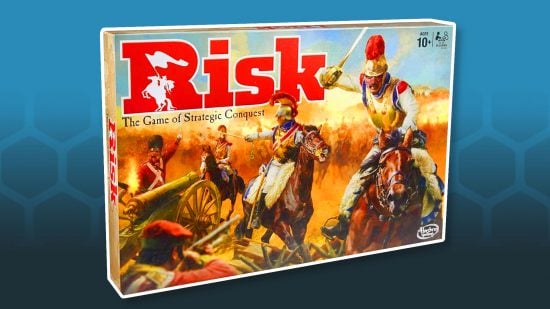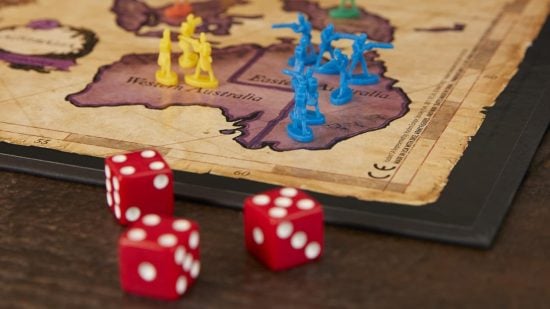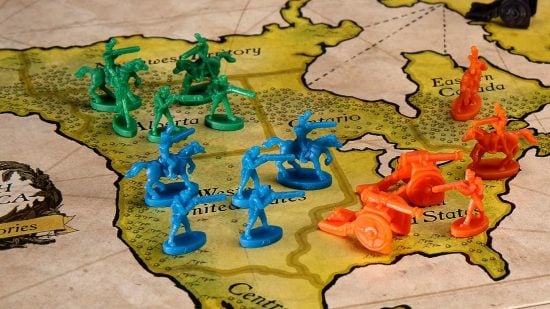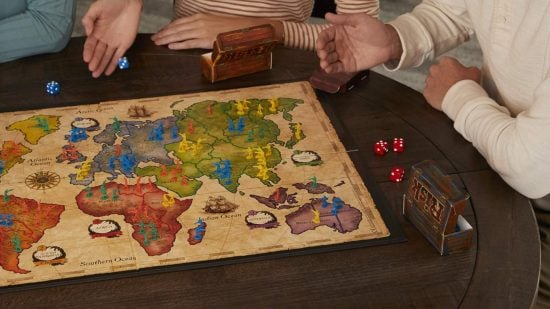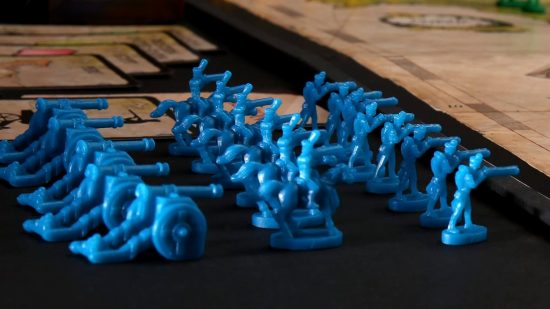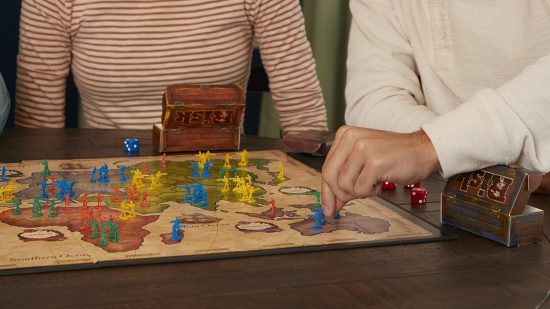While it’s an iconic board game that’s been around for decades, there are still plenty of people out there who haven’t gotten around to learning how to play Risk. And it’s worth doing – this highly strategic war game has stuck around for good reason. If you’re ready to spend hours mulling over globe-trotting tactics, we’ve got a Risk rules tutorial to help you get started.
Below you’ll find the core rules for the classic board game. But before we start, here are a few more guides to the best board games around right now. Fans of Risk should also make time to check out our list of the best strategy board games and historical board games.
Here’s how to play Risk:
- What is the goal of Risk?
- How many people can play Risk?
- How long does Risk take to play?
- How do you set up Risk?
- How do you play Risk?
- How do you play Risk with two players?
What is the goal of Risk?
During a game of Risk, your goal is to occupy all 42 territories on the board.
How many people can play Risk?
A standard game of Risk can host up to six players (though some variants of the game may suggest fewer players). It is possible to play Risk as a two-player board game, but you’ll need to use slightly different rules – more on this later.
How long does Risk take to play?
The length of a Risk game depends on a lot of factors, including how many players there are. It’s possible to finish the game in an hour, but it’s just as common for games to span eight hours – or even more.

How do you set up Risk?
A standard game of Risk comes with two sets of colored dice, a deck of Risk cards showing territories and secret missions, and a folding board depicting a world map. Also included are six different-colored armies, each of which includes three types of pieces: Infantry, Cavalry, and Artillery.
A Cavalry is worth five Infantry, and an Artillery is worth ten Infantry or Five Cavalry. You can replace any number of pieces with other types of equal value at any point in the game.
The number of units you start a game with depends on the number of players:
- Two players – 40 Infantry
- Three players – 35 Infantry
- Four players – 30 Infantry
- Five players – 25 Infantry
- Six players – 20 Infantry
These pieces are also called ‘armies’ in the official rules. However, to avoid confusion, we’ll refer to the three kinds of pieces as ‘units’, and ‘armies’ will refer to your complete collection of pieces.
Once everyone has their army, every player takes turns rolling one die. Whoever rolled highest places one of their Infantry pieces on any territory on the board.
Next, starting to the left of that player, everyone takes turns placing an army in an unoccupied territory. This carries on until all territories have one Infantry claiming them.
After this, everyone takes turns placing one new member of their army on a space they already occupy. Continue taking turns until everyone has run out of Infantry. Finally, shuffle the Risk cards (minus any Secret Mission cards – these are for a game variant found in some editions that we’ll cover in an update) and place them face-down beside the board.
You’re finally ready to play Risk! The player who placed the first army goes first.
How do you play Risk?
Every turn in Risk can be split into three steps:
- 1. Gain and place new units
- 2. Decide and resolve attacks
- 3. Fortify your position
1. Gain and place new units
At the start of each turn, you’ll gain a number of new units – this number changes depending on a few factors.
First, count up the number of territories you occupy and divide that number by three (rounding to a whole number). You receive a number of units equal to this number. You’ll always receive a minimum of three armies at this stage, even if you don’t control the right amount of territories.
You also receive units for controlling continents (meaning you occupy all its territories at the start of your turn). Different continents offer different bonuses:
| Continent | Number of bonus units |
| Australia | 2 |
| South America | 2 |
| Africa | 3 |
| Europe | 5 |
| North America | 5 |
| Asia | 7 |
Next, if you have collected three Risk cards, you can choose to trade them in for units at the start of your turn. If you have five or six cards at the start of your turn, you must trade in a set of three.
The number of units you receive depends on how many sets of cards all players have already traded in. For example:
| Order traded in | Number of units received |
| 1st | 4 |
| 2nd | 6 |
| 3rd | 8 |
| 4th | 10 |
| 5th | 12 |
| 6th | 15 |
After the sixth set is traded in, the number of units received increases by five each time. So the seventh set yields 20, the eighth 25, and so on. Remember that these numbers don’t repeat – if you’re trading in your first set but other players have already traded in four, yours is the fifth set, not the first.
If any of the three cards you trade in depict a territory you occupy, you get two extra units (which must be placed on the shown territory). This bonus only applies once per turn, even if the set you trade in shows multiple territories under your control.
2. Decide and resolve attacks
After you’ve gained and placed your new units, you can choose whether you want to attack a territory under an opponent’s control. You can only attack territories adjacent to one under your control or ones that are connected to yours by a dashed line. The territory you attack from must contain at least two of your units.
Begin by declaring which territory you’re attacking, as well as who you plan to attack. You and the opponent who controls the defending territory must declare how many dice you plan to roll. You must have at least one more unit in your territory than the number of dice you declare – if you have three units, you can only roll up to two dice, for example.
Your opponent gets to roll one or two dice (they’ll need at least two units in the defending territory to roll two). Once all dice are rolled, each player compares their highest result. The player with the lower result loses a unit from their territory that’s involved in the conflict.
If more than one die was rolled by both players, compare the next-highest results and repeat the process. Ditto with any subsequent pairs of dice rolled. The defender always wins ties in combat, and an attacker can never lose more than two armies on a single roll.
As long as you have control of territories that qualify to attack, you can attack as many times as you like on a turn. You may choose to repeatedly attack one territory in order to clear out all opposing units, or you may choose to attack several different territories.
When the last enemy unit on a territory is defeated, you must take control of that territory immediately. This means you move units equal to the number of dice rolled in your last battle to that space. You must always leave at least one unit on your old territory to maintain control – every territory always has at least one unit occupying it during a game of Risk.
If a player has their last unit removed from the board, the player that caused this gains all Risk cards the defender had collected. If they gain six or more cards this way, they must immediately trade in enough cards to reduce their hand to four or fewer.
As long as you don’t run out of opportunities to attack, you can declare the end of your attack phase at any time (you can also do this without attacking at all – just a reminder). If you gained at least one new territory, draw the top Risk card from the deck.
3. Fortify your position
The last part of your turn involves moving your units between territories you control. In this stage, you can move as many units as you want from one territory to an adjacent space. As per the rules for occupying a territory you’ve won, you must always leave at least one unit behind.
How do you play Risk with two players?
A two-player game of Risk largely follows the same rules, but each player starts with 40 Infantry, and it adds a ‘neutral’ army to the board to fill the gaps. This time, the winner is the first person to eliminate the others’ units – you don’t need to clear out the neutral armies.
In this version, setup begins by removing the Secret Missions and wild cards from the Risk deck and shuffling it. Deal the cards face-down into three piles, and have both players choose one. Roll off as usual to decide the starting player.
Then, taking turns, place your units in the territories shown on your cards – first one player, then the second, then the third neutral army that uses the remaining pile of cards. Once each territory is claimed, you’ll take turns placing two units onto any one or two of the territories you own. You’ll also get to play one neutral unit on any neutral territory.
Finally, return the wild cards to the Risk deck, shuffle it, and begin play. You can attack neutral territories as normal, and your opponent will roll on its behalf to defend. Neutral armies never attack or gain units.
For more tutorials, here’s how to play chess and how to play checkers. Or, for more in-depth tips and tricks, here’s our top Scrabble strategies and chess openings.
